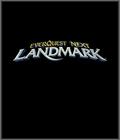EverQuest Next: Landmark represents something of a wild card at E3 2014. Though it shares similarities with other games, its unique mix of Minecraft-esque building mechanics and traditional MMO styling hasn't really been seen before. Landmark was demonstrated in a relatively early state, and at first, it was tough to figure out the game's concept. Ultimately, the game will be an MMO where you can literally shape the world as you see fit and also build castles, dungeons, and whatever else you want to create.
First, the building mechanics were shown. Players can lay claim to any part of the game's world, which gives them control over the permissions of who else — if anyone — can build on or modify the landscape. Players must gather materials for their creations from any unclaimed land and then use it to begin construction. The game is based on voxels in such a way that you can just as easily build a blocky structure as you can a perfectly spherical one. The game has a bevy of tools that the player uses to facilitate construction, such as copy/paste tools, quickly duplicating objects you want to reuse, and the ability to create an angled column of material using the line tool. Despite it being a voxel-based game, it is possible to construct something so detailed that it belies such a status.
In its current state, monsters do not exist in the game, but the plan is to implement them so players need to defend themselves as they navigate the wilderness. Down the road, players will also be able to take existing monsters and give them their custom artificial intelligence. The idea is that enterprising players can construct a giant castle and populate it with monsters, effectively creating their own instance for people to enjoy. A recently added feature of the beta was a cave system, which added surface caves that can be explored and pocket caves, which can only be found by digging into the ground and seeking them out. To find ore and other valuable items, an ore detector can be used to show the direction and distance of nearby ore veins. If you're close enough, the tool also shows the shape and composition of the vein.
Your creations can be saved and shared in the player's gallery, a listing of interesting creations submitted by players. Once approved, these submissions can be purchased with real money via the gallery. For every purchase made, the creator gets royalties, and it helps monetize the otherwise free-to-play game. It will be interesting to see what creations players come up with, especially given the sophisticated tools available.
EverQuest Next: Landmark clearly still needs some development time before many of the team's ideas come to fruition, but the direction shows significant promise. The goal is to allow players to shape the MMO's world, first by altering its landscape and then by populating it with their creations, both big and small. It is an MMO that lacks an easy comparison, short of calling it a natural extension of the gameplay popularized by Minecraft and taken to the next level as an MMO. As always, look for more information on the game as more of its features begin to take shape.
More articles about EverQuest Next Landmark











 EverQuest Next Landmark will combine the powerful and intuitive building tools SOE is using to create the fully destructible world of EQN with all of the social functionality expected from a modern MMO.
EverQuest Next Landmark will combine the powerful and intuitive building tools SOE is using to create the fully destructible world of EQN with all of the social functionality expected from a modern MMO.































